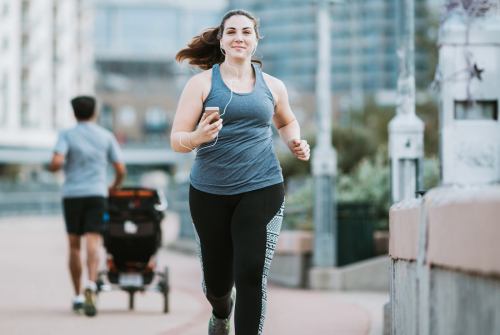Why working out without a mirror helps me love my body more
Checking yourself out could do more harm than good. One woman shares why ditching the mirror during workouts is the best way to exercise for self esteem.

As I adjusted the settings on my bike before a spin class got under way recently, one sports-bra-wearing rider nearby was busy moving her bike so she could have a direct view into the mirror. Nope, the bikes aren’t screwed into the floor, but hoisting 140 pounds of steel into a new spot was still a bold move—all in the name of shirtless self-adoration. Me, on the other hand? Given the choice between working out in front of a mirror or, heck, exercising while blindfolded, I’d pick door number two every time.
Years ago, I took my no-mirror policy to an extreme. I was so afraid of looking at my overweight body that I avoided them altogether, except for a two-inch compact case I used to apply my makeup. Even catching my reflection in a shop window or steel elevator door felt too painful. Maybe that’s why the only form of exercise I’d ever really enjoyed (or stuck to) in the past was swimming. In the water, I was able to shift the focus away from what I looked like and really tune inward, process my stress, escape harmful self-talk, and appreciate that there was more to me than cellulite.
Eventually, I discovered that working out on dry land could offer me all of the mental benefits I experienced when exercising in a pool—the key was to avoid all the distraction that the mirror provides. Because let’s face it, when it comes to our physical reflection, there is always more going on than meets the eye.
That’s why the rationale that fitness experts often give for using the mirror as a “tool” doesn’t always hold up. The Proper Form Police may tell you need a mirror so your back stays flat, tailbone stays tucked, and shoulders stay un-hunched. But what good is perfect form if the mental chatter that arises in the mirror threatens to take your focus away from your performance and cause you to zero in on your imperfections? One study looking at people with BDD (body dysmorphic disorder) and a control group of women with a healthy body image discovered that—yes, in both groups—10 minutes of mirror-gazing was enough to trigger appearance dissatisfaction. That may be why a quick outfit or makeup check doesn’t send me into a negative spiral, but a 45-minute HIIT class or hourlong yoga session in a mirror-lined room easily does.
What good is perfect form if the mental chatter that arises in the mirror threatens to take your focus away from your performance and cause you to zero in on your imperfections?
Sure, there is some truth to the thinking that you can’t deal with something—like negative feelings about your image—if you’re not even willing to look at it. That’s why after “mirror fasting” for so many years, I no longer practice strict avoidance. In fact, the first thing you’ll notice when you walk into my home are the large, window-like mirrors in my living room—a purchase I didn’t think twice about when decorating my apartment, but one I would have thank-you-nexted in the past. But what’s true for train wrecks is true for mirrors: knowing when to step away is as important as knowing when it’s OK to look.
Because if negative self-talk arises when you check yourself out mid-flow or rep, how much of the benefits of exercise can you really cash in on? It may sound counterintuitive to those who believe overweight people should be shamed into fitness (they exist, trust me), but I’ve seen my physical gains take a hit when I work out in front of the mirror. After all, it takes a certain amount of feeling good about myself to really push myself during my workouts, and if I’m not thinking about my size, I can more easily get into a groove. Freed from the labels I’ve assigned to myself, I can be anyone—like the girl I am when I’m pushing past my own limits, sprinting my legs as fast as they’ll go (instead of slowing down because I don’t think that “chubby” girls are capable of those speeds).
Bottom line: Stepping away from the mirror to see myself differently is one of the best things exercise does for my mind. But—call me vain—it’s also one of the best things I’m doing for my booty.
The best thing I did for my mental health was learning to separate my weight from my self-worth. And here’s how I learned to love old photos of myself—at every size.
Sign Up for Our Daily Newsletter
Get all the latest in wellness, trends, food, fitness, beauty, and more delivered right to your inbox.
Got it, you've been added to our email list.










